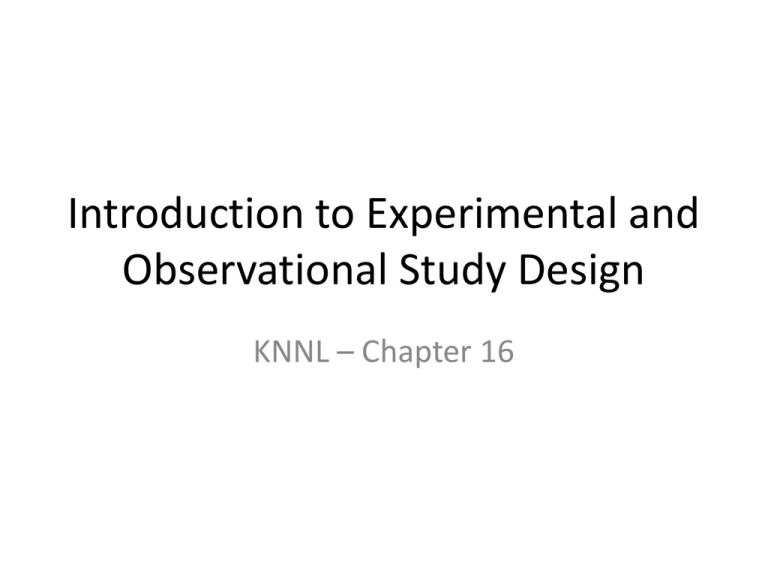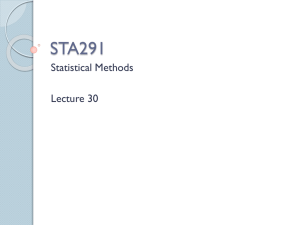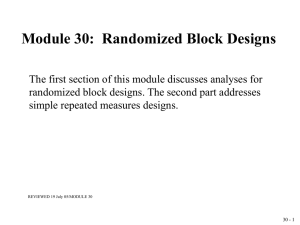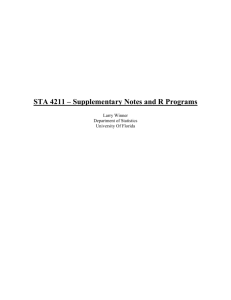KNNL-Ch15
advertisement

Introduction to Experimental and Observational Study Design KNNL – Chapter 16 Experimental and Observational Studies • Experimental Studies – Units (aka Subjects in human studies) assigned at random to treatments/conditions – Experimental Factors – Conditions with 2 or more levels, which are assigned to units. If there is more than one factor, treatments are combinations of factor levels assigned to units. • Observational Studies – Units are sampled from two or more populations/subpopulations – Observational Factors – Set of levels of Populations/subpopulations used in the study • Causation is directly obtained in Experimental Studies, not in Observational Studies • Mixed Designs Experimental & Observational Factors Basics of Experimental Studies • Explanatory Factors – Conditions (with 2 or more levels) that are assigned to units. – Crossed Factors – Factors with levels that are the same within levels of the other factor(s) – Nested Factors – Factors with levels that are different within levels of the other factor(s) • Treatments – Combinations of factor levels given to units • Experimental Units – Units used in the study, which are subject to randomization to treatments. • Randomization Process - Use of random number generator to assign units to treatments • Outcome measurement(s) obtained from treated units Completely Randomized and Blocked Designs • Experiment with One Factor @ 2 Levels (Treatments) • Completely Randomized Design – Take all subjects, and randomize so that half receive Trt A, and other half receive Trt B Yi = b0+b1Xi1+ei Xi1 = 1 if subject i received A, 0 if B • Randomized Block Design – Generate blocks of subjects that are similar wrt external criteria (gender, age,…) and randomize treatments to subjects within blocks. Helps make treatment groups more similar. Y = Overall Mean + Trt Effect + Block Effect + Error Standard Experimental Designs - I • Completely Randomized Design (CRD) – Units randomized to treatments with no restrictions on randomization process • Factorial Experiments – CRD with two or more crossed factors. Treatment effects are made up of main factor effects and interaction effects • Randomized Complete Block Design (RCBD) – Units are grouped into blocks. Treatments randomly assigned to units within blocks Standard Experimental Designs - II • Nested Designs – Levels of Factor B differ across levels of Factor A • Crossed/Nested Designs – Designs with both crossed and nested factors • Repeated Measures Designs – Each unit is measured multiple times – Each subject receives each treatment once – Each subject receives only one treatment, but is measured at multiple time points • Split-Plot Designs – Two (or more) sizes of experimental units due to randomization restrictions for factors Standard Experimental Designs - III • Incomplete Block Designs – Block Designs with block sizes smaller than the number of treatments • 2-Level Factorial Experiments – Several (possibly many) factors, each at 2 levels (low/high). With k factors, there will be 2k treatments • 2-Level Fractional Factorial Designs – Experiments with only a subset of all 2k treatments to reduce cost, but still obtain estimates of main effects and lower-order interactions • Response Surface Designs – Designs used to fit polynomial regression models for numeric factors Observational Study Designs • Cross-Sectional Studies – Observations made from populations/subpopulations at a single time point or interval. • Prospective Studies – Groups are formed by levels of a potential causal factor, then observed over time for some measurable outcome. • Retrospective Studies – Studies where subjects are identified based on the outcome of interest, potential risk factors are identified that previously occurred • Matching – Subjects from different populations are matched, based on external factors – like blocking








